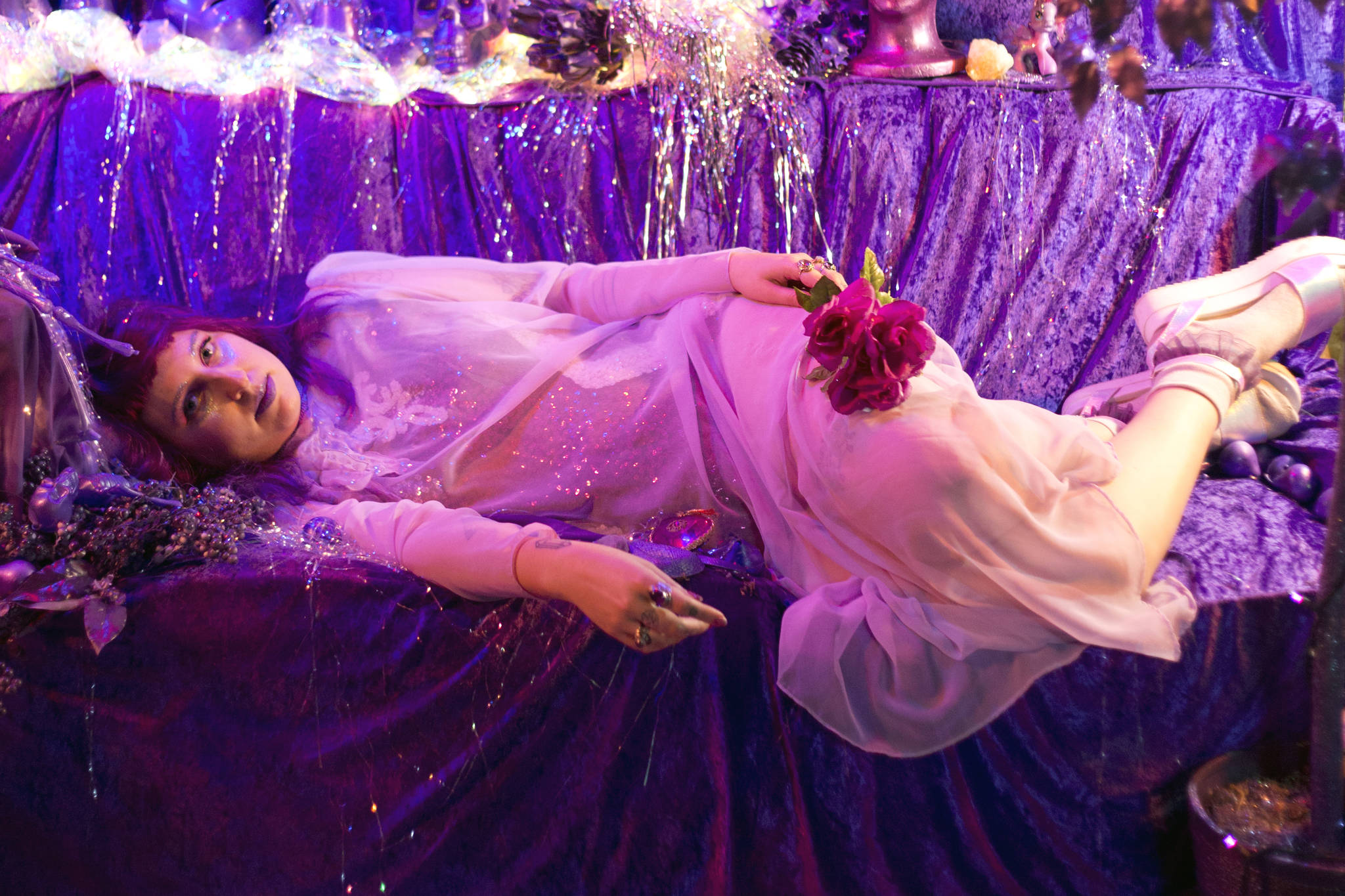“Dreamy” is easily the first word that comes to mind when listening to Lilac’s music. Truly, it’s not hard to imagine that her songs were forged in some otherworldly subconscious realm. Using a sampler and a Casio XW-P1 synthesizer, Madeline Franks crafts electronic music like magic spells, her satiny vocals unfolding as mesmerizingly as fresh taffy being pulled.
The 27-year-old songwriter, who adopted the name Lilac for her solo project after a friend dreamed of her with purple hair, says many of her songs were inspired by her vivid lucid dreaming, a gift that runs in her family. In these dreams, she’s often led by different figures or guides. “I have this woman or femme person, with really long dark hair, and she would tell me certain things in my dreams, or take me to certain really visually stunning places,” she says.
Sometimes these settings skew sylvan and shadowy, as in one dream where she was brought to perform a ritual in the woods (“I feel like nature is magic,” she says). Other times they take place in houses, like a recent dream in which she rummaged through a home full of forgotten toys, reminiscent of the scene in the 1986 film Labyrinth where Jennifer Connelly’s character Sarah discovers a junkyard of childhood belongings. In her waking life, Franks is a similarly tireless scavenger, sifting through thrifted treasures and colorful textiles in her day job as a buyer at Lucky Vintage in the U-District, where she salvages discarded knickknacks from used bins for her multimedia artwork.
As in Labyrinth, being lost in mazes is a recurring theme in her dreams, which inspired the track “Walking in a Maze” on her forthcoming tape, You Can Call Me Papa, out Sun., Aug. 27. On it she sings “I’ve seen you in my dreams, on TV/Why do you torment me?/Why do I torment myself?” The song was also inspired by a personal relationship that was disorienting her at the time. “I think dreaming of houses and mazes makes sense to me because I moved around a lot when I was a kid,” she says. “There was a lot of movement and environments, because my parents were [getting] divorced. There were a lot of different spaces.” Furthermore, houses also symbolize a sense of self or identity to her, in keeping with psychoanalyst Carl Jung’s traditional interpretation.
You Can Call Me Papa surfaced a newfound alter ego for Franks. In a way, names, like Lilac, function as a way to unlock dormant aspects of her personality and reveal their full potential. The album’s title comes from friends affectionately nicknaming her “Papa,” which struck her as funny and odd, but later came to represent an emerging queer identity for her. On the album’s cover art, shot by her photographer friend Frank Correa, she wears a leather harness another friend made and poses as a peacock. The image made her feel “sexually empowered” and “fierce in this way that I didn’t realize that was part of me.” The song “Purple Velvet,” which Franks is working on a video for with artist Leena Joshi, is about learning to feel comfortable and at home in her queerness.
Much of Franks’ work is about reclaiming femininity for herself. On “What Do You Feel,” over a beat with driving, persistent urgency, her voice steadily climbs to an angelic apex as she declares, “What you feel is real.” The song was written about her and her friends’ experiences being expected to behave submissively and sublimate their own voices or emotions. “I’m tired of being silenced or feeling like I have to be polite,” she says.
Motifs of distorted femininity cross over into her visual art as well. Franks makes multimedia art—drawings, paintings, and collages that manipulate and magnify feminine tropes. She often includes dolls, toys, glitter, and gems in her work, drawn to the plastic and artificial sparkle. One series of paintings, which she created for the femme electronic-music collective TUF’s “TUF Love” event, reimagines Barbie dolls in unexpectedly witchy roles.
She draws inspiration from “anything ’60s and ’70s, anything Technicolor,” citing the highly supersaturated palette of Anna Biller’s retro art-house flick The Love Witch. The film, about a beautiful young witch who seduces men and drives them to madness with her love spells, aligns with Franks’ own highly stylized aesthetic and emphasis on hyperfemininity. Franks is also influenced by movies like The Pink Panther, as well as cartoons like Sailor Moon and She-Ra.
Franks often thinks about fate and synchronicity: In a previous interview, she told Seattle Weekly that “I feel like Lilac is something I’m actively becoming that’s always secretly been inside of me, like it’s my destiny or something.” She says some of her dreams, like one in which she discovered a forgotten childhood object in a vanity, have turned out to be premonitions.
“You seem familiar to me/Have we met in a past life?” she wonders on the track “Soulmates,” as an undercurrent of repetitive, swirling resonances simulates the freaky familiarity of déjà vu. A preternatural calm sets in as she sings about feeling safe around this stranger. When she wrote it, she was thinking about the uncanny nature of “loving connection.” “There’s a familiarity, it seems like. Even with friends, in general,” she says. “Like, where does it feel like I’ve known them before?”
She believes in past lives, and that a special calling to create permeates her current one. “It seems like in this life, there’s some kind of purpose, like I’m supposed to make art and share it,” she says, “and I feel really strongly about that.” n
music@seattleweekly.com








